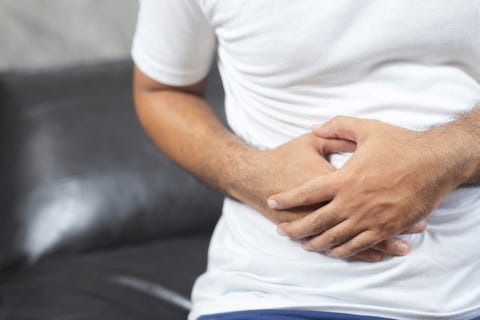What Can I Drink on Low Fodmap Diet
Chances are, you've heard of FODMAPs or a low-FODMAP diet. The diet isn't intended for long-term use—it's a type of elimination diet to try to figure out what may be causing stomach issues, like irritable bowel syndrome (IBS), according to Johns Hopkins Medicine.
So what are FODMAPs anyway? The acronym stands for, wait for it, fermentable oligosaccharides, disaccharides, monosaccharides, and polyols. Yep, that's a mouthful and doesn't explain much unless you're familiar with chemistry. In layman's speak, FODMAPs are types of sugars, and your small intestine can have a hard time digesting them.
When that happens, people might experience GI distress, including gas, bloating, diarrhea, and constipation.

Men's Health
That's because FODMAPs draw extra water into the intestine and are rapidly fermented by bacteria in the bowel, explains Frances Largeman-Roth, R.D.N., author of Smoothies & Juices: Prevention Healing Kitchen: 100+ Delicious Recipes for Optimal Wellness.
Research has found a low-FODMAP diet reduced symptoms of IBS and small intestinal bacterial overgrowth (SIBO) in up to 86 percent of people.
The low-FODMAP diet is not a weight-loss plan, according to Johns Hopkins Medicine. It's designed to determine what foods trigger GI symptoms, and create an eating plan to reduce or eliminate those symptoms.
Health experts encourage people who think they might benefit from trying a low-FODMAP diet to work with a doctor or registered dietitian. Like all elimination diets, it's important to make sure you're getting the nutrients you need.
So, what foods can you eat and which should you avoid, on a low-FODMAP diet? Let's take a look.
What Foods Should I Avoid on a Low-FODMAP Diet?
Foods that are high in FODMAPs, meaning ones that can cause GI symptoms, include:
- Dairy-based milk
- Dairy-based yogurt
- Dairy-based ice cream
- Wheat-based foods, including cereal, bread, and crackers
- Beans and lentils
- Certain vegetables, including artichokes, asparagus, onions, and garlic
- Certain fruits, including apples, cherries, pears, and peaches

Photographer, Basak Gurbuz Derman Getty Images
Lactose, the sugar found in dairy, is a high-FODMAP food. The fruits that are high in FODMAPs contain high levels of polyols—which put the "P" in FODMAP. Wheat, garlic, and onions are high in fructans—one of the oligosaccharides.
You'll also want to avoid or cut back on certain cruciferous veggies, and beans and lentils (despite them being high in good-for-you fiber) because they can cause excessive gas.
What Foods Can I Eat on a Low-FODMAP Diet?
Like all restrictive diets or eating plans, it can be hard to find foods you can eat. And when it comes to a low-FODMAP diet, you want to find foods you can safely eat. These include:
- Eggs
- Meat
- Certain cheeses, including brie, Camembert, Cheddar, and feta
- Almond milk
- Certain grains, including rice, quinoa, and oats
- Certain vegetables, including eggplant, potatoes, tomatoes, cucumbers, and zucchini
- Certain fruits, including grapes, oranges, strawberries, blueberries, and pineapple

Mariha-kitchen Getty Images
While there is some overlap between a low-FODMAP diet and a gluten-free diet, they're not the same thing. That said gluten-free foods tend to be lower in oligosaccharides.
Once you have an idea of your safe foods, it's time to get creative, says Josh Axe, D.C., D.N.M., C.N.S.
"Eggs with a slice of sourdough bread or steel-cut oats sweetened with maple syrup and blueberries are great breakfast options for the low FODMAP diet," he says. "You can also eat wild-caught fish seasoned with lemon juice, along with quinoa for dinner."
How Long Should I Stay on a Low-FODMAP Diet?
Elimination diets are not intended for long-term adherence. The elimination phase—when you cut out those high-FODMAP foods—should only last two to six weeks, Axe says.
It's important to log your symptoms as you re-introduce one food at a time, to help determine problem foods. If you re-introduce more than one food at a time and experience symptoms, it's nearly impossible to figure out which food caused the problem.
"Working with a registered dietitian can help design a plan that avoids FODMAPs while making sure you're still getting the nutrients you need to be healthy," Largeman-Roth says.
Are There Any Side Effects on a Low-FODMAP Diet?
It might be ironic that one of the biggest complaints about a low-FODMAP diet is constipation. After all, you're trying to reduce GI issues, right? But temporary constipation is normal, due to decreased fiber intake, Largeman-Roth says.

Rattankun Thongbun Getty Images
She recommends eating a wider range of low-FODMAP foods, instead of eating the same ones day in and day out. If you're still having problems, it's important to speak with a healthcare professional or registered dietitian to find safe ways to incorporate more fiber.
So, should you try a low-FODMAP diet? Largeman-Roth says if you've experienced long-term digestive issues, it could be worth exploring to try to pinpoint trigger foods.
"In my experience, many people who exclude all of the offending foods are able to reintroduce many of them over time, while still keeping their symptoms under control," Largeman-Roth says.
Heather Mayer Irvine Freelance Writer Heather is the former food and nutrition editor for Runner's World, the author of The Runner's World Vegetarian Cookbook, and a seven-time marathoner with a best of 3:31—but she is most proud of her 19:44 5K and 5:33 mile.
This content is created and maintained by a third party, and imported onto this page to help users provide their email addresses. You may be able to find more information about this and similar content at piano.io
What Can I Drink on Low Fodmap Diet
Source: https://www.menshealth.com/nutrition/a19455832/low-fodmaps-diet-guide/